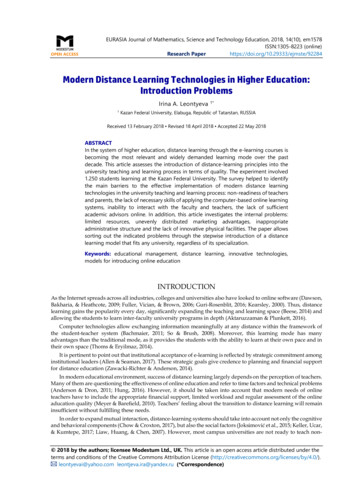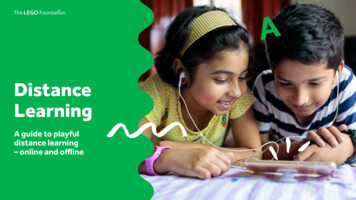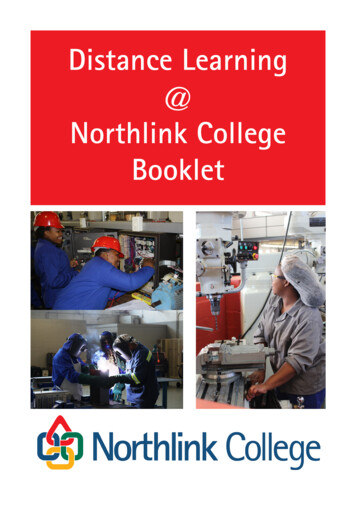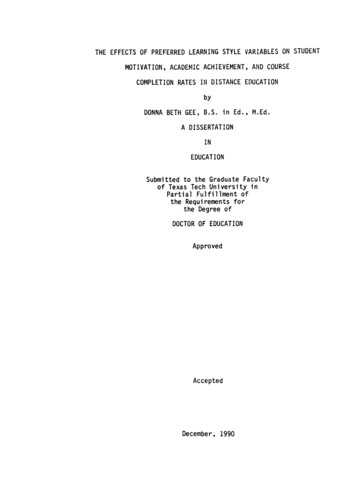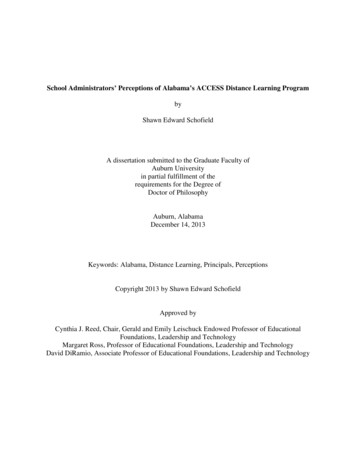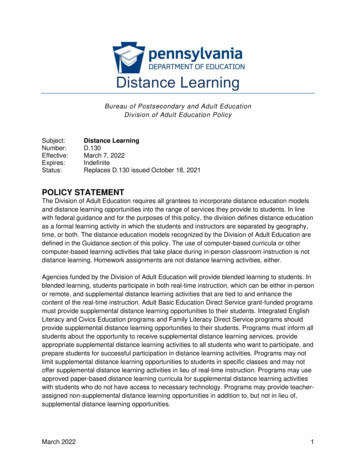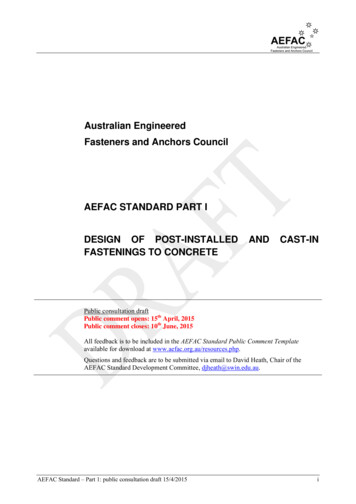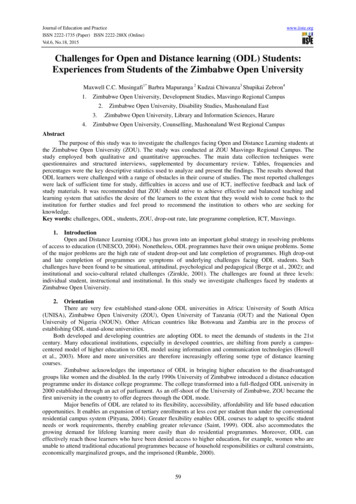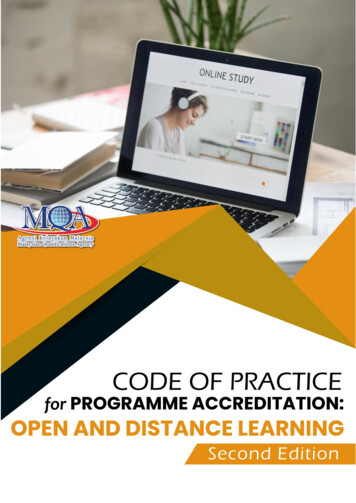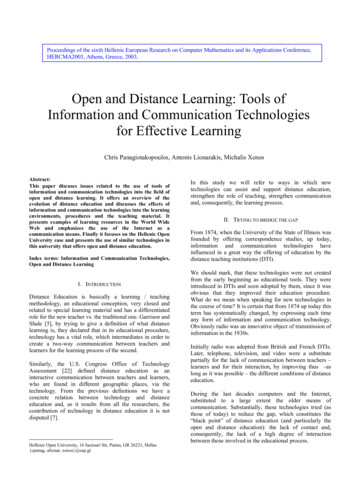
Transcription
Proceedings of the sixth Hellenic European Research on Computer Mathematics and its Applications Conference,HERCMA2003, Athens, Greece, 2003.Open and Distance Learning: Tools ofInformation and Communication Technologiesfor Effective LearningChris Panagiotakopoulos, Antonis Lionarakis, Michalis XenosAbstract:This paper discuses issues related to the use of tools ofinformation and communication technologies into the field ofopen and distance learning. It offers an overview of theevolution of distance education and discusses the effects ofinformation and communication technologies into the learningenvironments, procedures and the teaching material. Itpresents examples of learning resources in the World WideWeb and emphasizes the use of the Internet as acommunication means. Finally it focuses on the Hellenic OpenUniversity case and presents the use of similar technologies inthis university that offers open and distance education.Index terms: Information and Communication Technologies,Open and Distance LearningI. INTRODUCTIONDistance Education is basically a learning / teachingmethodology, an educational conception, very closed andrelated to special learning material and has a differentiatedrole for the new teacher vs. the traditional one. Garrison andShale [5], by trying to give a definition of what distancelearning is, they declared that in its educational procedure,technology has a vital role, which intermediates in order tocreate a two-way communication between teachers andlearners for the learning process of the second.Similarly, the U.S. Congress Office of TechnologyAssessment [22] defined distance education as aninteractive communication between teachers and learners,who are found in different geographic places, via thetechnology. From the previous definitions we have aconcrete relation between technology and distanceeducation and, as it results from all the researchers, thecontribution of technology in distance education it is notdisputed [7].Hellenic Open University, 16 Sactouri Str, Patras, GR 26221, Hellas.{cpanag, alionar, xenos}@eap.grIn this study we will refer to ways in which newtechnologies can assist and support distance education,strengthen the role of teaching, strengthen communicationand, consequently, the learning process.II. TRYING TO BRIDGE THE GAPFrom 1874, when the University of the State of Illinois wasfounded by offering correspondence studies, up today,information and communication technologies haveinfluenced in a great way the offering of education by thedistance teaching institutions (DTI).We should mark, that these technologies were not createdfrom the early beginning as educational tools. They wereintroduced in DTIs and soon adopted by them, since it wasobvious that they improved their education procedure.What do we mean when speaking for new technologies inthe course of time? It is certain that from 1874 up today thisterm has systematically changed, by expressing each timeany form of information and communication technology.Obviously radio was an innovative object of transmission ofinformation in the 1930s.Initially radio was adopted from British and French DTIs.Later, telephone, television, and video were a substitutepartially for the lack of communication between teachers –learners and for their interaction, by improving thus –aslong as it was possible – the different conditions of distanceeducation.During the last decades computers and the Internet,substituted to a large extent the older means ofcommunication. Substantially, these technologies tried (asthose of today) to reduce the gap, which constitutes the“black point” of distance education (and particularly theopen and distance education): the lack of contact and,consequently, the lack of a high degree of interactionbetween those involved in the educational process.
Proceedings of the sixth Hellenic European Research on Computer Mathematics and its Applications Conference,HERCMA2003, Athens, Greece, 2003.III. THE EFFECT OF INTERNET AND THE EVOLUTION OFvideocassettes – software (supported learning withPCs) – interactive video.DISTANCE EDUCATIONA. Evolution of distance educationWith the rapid invasion of computers and networks in thedaily human activities once again new technologies tried,adopted from the DTI, to serve education. Thus, in themiddle of 2000 the British Open University granted the firstpostgraduate diplomas of specialization to its students fromthe entire world who attended courses via Internet.Also, in the twilight of 20th century hundreds ofconventional universities all over the world have directed apart of their operations in benefit of distance education withthe use of new technologies. For example: In USA the Universities of Illinois, Phoenix, NewYork, Stanford and California (UCLA) began tofunction with virtual classes using the Internet.In Great Britain, through the operation of InternetUniversity, traditional academic colossuses begancollaborations for an exclusively on-line coursesdelivery. Other colleges have moved already towardsthis direction independently or through the union“Collegenet”.Inter-university agreements among Mega Universitieslike Oxford, Stanford, Princeton and Yale attributed anew virtual university, named as University Alliancefor Lifelong Learning – UALL, aiming at the offeringof continuing education via the Internet. Essentialequipment of their students is: a multimedia PC,software of Internet exploration, software of electronicmail and a video camera.Is however so much easy for an institution that offerstraditional education to alter as an institution of distanceeducation? No, according to Clay [2]. There are essentialreasons that often deter such a transformation or partialchange. Among these, there are: The different role of the teacher / tutor,The Lack of technical and administrative support,Decreased quality of studies,Increased pressure of work andNegative attitudes of the staff within the institution.As it appears, important effect in the configuration and inthe evolution of distance education was the release and freeaccess of the Internet (April 1995). Up to thencommunication, the educational material and the support ofdistance learning process were limited, respectively, in:(a) Postal correspondence – telephone – fax,(b) Printed educational material – radio transmissions –televisiontransmissions–audiocassettes,After 1995, with the rapid distribution and use of Internetand the network conjunction of the planet, there werecreated moreover possibilities for: Access to information and leaning sources that arefound in the World Wide Web (World Wide Web –WWW resources),Communication and distance teaching, with the use ofnetworks and PCsIt should be mentioned here that roughly the 70% ofcertified colleges with four years of study and gradedschools in the USA offer to their students, apart from thetraditional teaching, courses via Internet [16].B. Virtual UniversitiesInternet allowed something more from all the other forms oftechnology: the creation of completely virtual institutions,which with minimal personnel (and cost of operation, costof studies) can offer high standards of education. Thus, in1999 arose through the Internet the Jones InternationalUniversity (JIU), the first completely virtual university,with the right approval from the academic authorities ofUSA.As it appears, the 1874 studies by correspondence wereconverted to studies of 2002 with electronic correspondence/ communication, transmission of pictures and thetraditional classes to virtual classes.The operation of the virtual classes [17] and themanagement of educational process exclusively via newtechnologies present obvious advantages, as independencein time, independence in space, flexibility, simplicity andstability in the utilization of interface of communication andguidance.However, this presents important disadvantages, as:difficulties from the non catholic spread of the Internet andproblems from the use of new technologies in distanceeducation, as isolation of the student, lack of safety andcopy rights, lack of standards according to the quality [11]etc.IV. EDUCATIONAL TECHNOLOGY AND EDUCATIONALMATERIALA. Technology and materialThe used technology that is found today in the DTIs inorder to support the educational process varies, and it is
Proceedings of the sixth Hellenic European Research on Computer Mathematics and its Applications Conference,HERCMA2003, Athens, Greece, 2003.difficult to be categorized. However, most DTIs [6] use thefollowing ways to strength the offering of education to theirstudents: Face-to-face meetings / tutorials between tutors andstudents; technology can help, at least, with themultimedia software and the presentation software. Thedata projector suppresses the overhead projector anddoes the presentation more attractive with sound andpicture.The World Wide Web constitutes space of report ofvarious information. Its use study programs, thereminder of obligations of the students and certainimportant dates constitute usual phenomenon for mostDTIs.The World Wide Web, apart from space ofinformation, can be useful also as space of assistance ofthe study programs. This tactic is usual also in thetraditional educational institutions. Thus, students viathe World Wide Web, from the library or their personalcomputer can have access to the educational –teaching material that refers to all the study program orpart of these.Offering of distance education via the Internet. Thecommunication for the educational process can besynchronous, asynchronous or even both.software of this type, functions in order to help the rest ofthe material and it aims at the comprehension of difficultpoints of the material or at the analysis of those pointswhere the majority of students makes errors.The learning environments are manufactured under theeffect and the principles of various theories of learning. Inthe decade 1990-2000 there were studies and research withimportant results. The majority of applications ComputerBased Learning (CBL) are supported by the theories ofconstruction of learning (constructivism). These theoriessupport learning via activities which involve actively theuser / learner and assist him so that he will structure (create)and discover his knowledge [13, 18].V. LEARNING RESOURCES AND THE WORLD WIDE WEBThe World Wide Web constitutes an inexhaustible space ofinformation. According to Relan and Gillani [19], Santi[20] and Crossman [3], the basic characteristics of learningenvironments that can be created in the World Wide Webare: Usually the teaching material of the study programs viaWorld Wide Web includes:(a) The teacher’s introduction with multimedia elements,which can be with text or with compressed video.(b) Special software relative to the material, which isreceived via the network or the student can “download”it and work with his personal computer.(c) Other educational materials, which the student can“download” in his personal computer, such as: files oftext with questions, files of sound and pictures, files ofvideo.(d) Exercises / activities for practice, written tests (even forbeing-line completion and automatic correction).(e) Connections with information resources, such as:libraries, published articles in the World Wide Weband scientific journals.The totally virtual institutions of distance education followthe previous provision of educational material, which isfollowed from the timetable of study and with reminder ofimportant dates.B. The educational software and the learningenvironmentsAs it appears from the precedents, the educational materialof DTIs is polymorphic and multifunctional. Some forms ofthis material, which is activated with computer, aims at thecreation of learning environments [21]. Usually the The limits of learning are extensive and not limitablefrom space. The earner can use the environment oflearning in the classroom, in his house, in places ofentertainment and in his work. Thus, one of the ideal ofOpen Education that points out that the student has theright to determine the place of his study [10] findsground for absolute application.The surfing in the World Wide Web takes place in anon serial way. The access to the source of informationeach time with the use of hyperlinks can be direct.Information can be approached with many differentways with the use of multimedia, by promoting activeattendance and learning.Social interactions and cooperative methods of learningare supported with synchronous and asynchronousways of communication.The operation of learning environments is reliable andtheir cost small if it is compared to the one in learningenvironment supported by computers (Computer BasedLearning – CBL), or to the one which uses radioprograms, television transmission or a videofilm1.The World Wide Web, with the exploitation of itscharacteristics and its resources, constitutes for the visitor alearning environment, full of information which istransmitted by multiple means. In this environment, thelearning process can be promoted, supported and cultivated[8].1The videofilm can constitute an appreciable learningsource, but as serial material means of transmission ofinformation it doesn’t enclose the possibility of interactionand it cannot promote learning considerably.
Proceedings of the sixth Hellenic European Research on Computer Mathematics and its Applications Conference,HERCMA2003, Athens, Greece, 2003.For the growth of courses and teaching material that can beexposed in the World Wide Web various tools are used,such as Microsoft FrontPage, Netscape Composer orMacromedia DreamWeaver. More specialized are theeWeb, the Serf Distance Education Environment, theCyberProf, and the CourseWriter.Certain tools are even more powerful, by giving to its usergreater possibilities, not only of creation of teachingmaterial, but also of management of virtual class,communication with text, sound and video, bulletin board,facilitation of educational process etc. Common toolsplatforms are: Blackboard, WebCT, e-Education, CompleteOn-Line Teaching System, Virtual-U, Creator, Collegis. Insuch platform of software, which the students can approachvia the World Wide Web, the main learning activities thatcan be developed are: statements from the teacher / tutor in special “tables ofstatements” (bulletin-boards),statements from the students / learners,suspension of texts with teaching material from theteacher / tutor,downloading of educational material from the students,implementation of small multimedia applications,mission of mass e-mails in the members of the group,synchronous communication among the members withtext, sound or even video,approach in special information (exercises, work,degrees, important dates etc).Certain platforms of education and communication via theWorld Wide Web include meeting space with written text(chat-room) and allow the use of whiteboard. Thewhiteboard it is a designing tool that can be used in on-linediscussions. It allows the typing of text, the import ofobjects and graphics. The teacher can also picture ready“pages”, which are received in real time from all themembers of the group connected to the platform ofcommunication of DTI and are allowed. Through the chatroom discussions are carried out with written text (also inreal time) and questions are asked to the teacher, who hasthe possibility to answer with the time line that thequestions roll up (first-in, first-out).The evolved platforms of communication and educationallow:(a) the transmission of information (that is to say “pages”,with forms, text and graphics) that that the teacherwants to give to his students and(b) the simultaneous transmission of picture and sound ofthe teacher in a “window” of the PC screen (WebCast).So, the user has the possibility, through suitableconnections (links) of the learning environment to visit,virtual libraries, articles and bibliography that is exposed inthe World Wide Web by educational institutions but alsoon-line scientific magazines.However, it is not enough for somebody to place amultimedia application in a server of the World Wide Web(web server) and become acceptable as he createdinfrastructure of teaching environment for open anddistance education. Certainly, for Open DTIs, theinformation and the learning environments which will becreated in the World Wide Web should follow and acceptprinciples and elements of the methodology of distanceEducation and the Education of Adults.VI. COMMUNICATION VIA INTERNETIt should it is stressed that the role of teaching in the DTIs iscomplex and more exigent than that of traditionalinstitutions. The communication between teacher andstudent, but also among the learners, is a fundamentalcomponent of the educational action.Internet constitutes a powerful mean of support andcommunication but also the teaching process in the DTIsand in some certain forms (e.g. e-mail) with exceptionallysmall cost. It can offer new possibilities, changing theteacher-oriended type of education into the student-oriented[15].A. Synchronous and asynchronous communicationHaving as parameters the space and time in which there arefound the teachers and the learners, communication, as itappears in Table 1, can be separated [12].Table 1. Types of communicationSame timeDifferent timeSame placeTraditional Different placeSynchronousAsynchronousCommunication between teacher and learner in the sametime and same place, refers to the traditional classroom.When teachers and learners communicate by being at thesame time in different places, then communication is cation takes place in different time and in differentplace. These two last forms of communication, which arerun via the Internet, support today the virtual classes ofDTIs.If we tried to realize the basic elements of the two ways ofcommunication between teacher and learner, we wouldobserve the following [1, 4] as shown in Table 2.
Proceedings of the sixth Hellenic European Research on Computer Mathematics and its Applications Conference,HERCMA2003, Athens, Greece, 2003.Table 2. Elements of the two ways of communicationParametersMotivation on behalf ofthe teamPossibility ofinteractionFeedbackStudent supportIsolation of the studentFlexibility in space andtimeBreadth oftechnologicalinfrastructure of DTICost for student andDTITime for thought andcontrol by the studentMotivation for ‘contact’with the teachingmaterial as it isforecasted by the studytimetableSynchronousto a large extentAsynchronousin small esbigsmallbigsmallminimalbigto a large extentin small degreeAmong the modern methods of communication we find: the telephone communication,the sound-conference via connected computers (audioteleconferencing),the video-conference via connected computers (videoteleconferencing),the conference with the use of “whiteboard”,the use of applications of chat-room type (supported intext).C. Types of asynchronous communicationAmong the asynchronous methods of communication wefind: Insofar, for synchronous and asynchronous communicationcan be used: radio transmission, cable television, satellite transmission of vision.From the used technologies via the Internet, the electronicmail and the applications that provide discussion (chatrooms) we have worldwide the most common means ofsupport of the learning process in distance education. Theprevious means, with the tables and videoconferences,encourage the distance cooperation.VII. THE VIDEOCONFERENCEB. Types of synchronous communication compressed video-sound (streaming video-audio), with thehelp of suitable software.the use of fax,the use of computer software (educational Cd-rom),the use of videofilms,the use of audio tapes,the use of compressed video,the courses supported by the World Wide Web,the bulletin boards in the World Wide Web,the electronic post (e-mail).From the above methods of communication thevideoconference is very interesting [9]. With it, two or moreparts, including technology, can be connected with soundand vision in real time. The transport of sound and pictureis achieved with the transmission – reception of signal ofThe videoconference, which gives the possibility for faceto-face communication and guidance, constitutes a usefuleducational tool. Many DTIs have adopted it, as means offacilitation of communication and educational activitybetween teacher and learner. However, it cannot supportexclusively the educational process in a DTI [14]. Theimportant advantage that is offered with its use is the widescale of interaction that can take place among theparticipants. It can be separated in videoconference of mainroom and videoconference of point to point –videoconference of multiple points.VIII. THE HELLENIC OPEN UNIVERSITYIn Greece things are somehow different concerning thepossibilities which can be found in new technologies andtheir adoption by various DTIs worldwide. The illiteracyamong adults of the use of PCs and the provided servicesfrom the Internet with still low speeds of flow of dataconcerning the relatively high functional cost of connectioncannot currently render the modern technological meanscores of exclusive support of educational activity from alocal DTI.As it results from the proceeding of the Governing Boardmeetings, the Hellenic Open University (HOU) with carefulsteps tries to adopt progressively the use of newtechnologies to the benefit of the administrative andeducational process. As most Institutions of HigherEducation it has the resources. But do the students have?The complete incorporation and adoption of newtechnologies today globally (for all that is to say theprograms of study) by the HOU will constitute rather causeof breach of one ideal that it invokes: the access of equalopportunities of education to all Greek citizens. The printed
Proceedings of the sixth Hellenic European Research on Computer Mathematics and its Applications Conference,HERCMA2003, Athens, Greece, 2003.educational material should remain the heart of educationalmaterial of the students for most study programs, until theoverwhelming majority of citizens have the possibility ofaccess to the Internet, and in particular with speeds of flowof data that allow completely his exploitation as educationaltool.the students in managing their time and selecting theappropriate material.The tutors’ forum proved to be valuable in coordinating thisconsulting effort, while students’ fora were developed forspecific module groups. Although the majority of studentswere in favor of using a forum (approximately 75%), thestudents’ fora were not all successful. The success of aforum proved to be strongly related to group specificitiesand the tutor-student preferred communication style. Inmany cases the use of e-mail and the provision of a groupspecific web site including an announcement board wasmore effective than the forum.Figure 1: Entry point of INF10This does not mean, of course, that the production ofalternative material and research will continue to thedirection of complete incorporation of new technologies inthe institution.Already, in study programs where the students profileallows more rapid adaptation in new technologies,important changes have begun with regard to the infiltrationof new technologies. For example in the Informatics Coursethe e-mail had already been established as the basic meansof student-tutor communication for almost 100% of thestudents (including the newly registered tronically. The central web site now offered onlygeneric information, while specific web sites (portal-like)were provided for each module. Figure 1 shows the entrypoint of the module INF10 student site.Although the students’ response to the above changes wasenthusiastic, a few educational problems occurred. Makinga variety of additional material available to students createdthe need for providing further guidance to each studentabout selecting the material that suits his/her particularneeds best. This caused a slight change in the tutor’s rolewho now undertook a more consulting role, having to aidFigure 2. A typical Webcast.During the current academic year 2002-2003, each tutorstudents group in the Informatics Course uses either aforum, or a group specific web site and e-mail forcommunicating, depending on the specific group needs andthe module. During this year an important step was takentowards the adoption of new technologies by setting upstudent groups such as the A14 group in INF10. This groupcomprises 32 students, geographically distributed amongthe Aegean Islands. The first meeting of this group was heldin Athens, while all the rest were held in a virtualclassroom2. In the latter case the students had theopportunity to join the virtual classroom and attend themeeting from their island. All meetings were recorded andmade available through the group’s web site so that thestudents can review them later, or be briefed on what wasdiscussed in case they had not joined the meeting.Furthermore, Webcasts, such as the one shown in Figure 2(also called video lectures) were developed and offered2Based on CentraOne 6.0
Proceedings of the sixth Hellenic European Research on Computer Mathematics and its Applications Conference,HERCMA2003, Athens, Greece, 2003.through portals, while HOU will store the entire materialrequired for a course module and then mail it to studentswith no extra cost, since such mailing can be bundled withthe scheduled mailing of printed material.[7][8][9]From all these we conclude that the Hellenic OpenUniversity:[10](a) is directed to a complete incorporation of newtechnologies when the conditions will allow it,[11](b) contributes to the demystification and to the acceptanceof use of new technologies from wider layers of Greeksociety.[12][13]IX. CONCLUSIONThe model of the industrial season, of traditional educationwith the black board and the chalk appears to belong to thepast. Distance education appears strengthened with the useof new technologies, where can be found and coexist withtraditional education.[14][15][16][17]In distance education the facilitation of the virtual studentsfrom the new technologies is obvious. They can work, stayat home and study without any social, family or otherproblem. The advantages are many, but also thecompensation rather important: they are deprived theexperience of student life, the freedom that this exudes, aswell as social connection. Particularly in distance educationthe use of Internet, with peak the videoconference, candecrease the lack of contact between teacher and studentand strengthen the educational process. As it appeared fromthe precedents, the new technologies do not constitutesimply an alternative solution, particularly for ][2][3][4][5][6]Aoki, K. & Pogroszewski, D. (1998). Virtual UniversityReference Model: A Guide to Delivering Education and SupportServices to the Distance Learner. On line Journal of DistanceLearning Administration, 1, 3.Clay, M. (1999). Development of Training and Support Programsfor Distance Education Instructors. On line Journal of DistanceLearning Administration, 2, 3.Crossman, D. M. (1997). The Evolution of the World Wide Web asan emerging instructional technology tool. In Khan, B. H. (ed.),Web-based Instruction. Englewood Cliffs, N.J.: EducationalTechnology Publications.Ellis, B. (1997). Virtual Classroom Technologies for DistanceEducation: The Case for On-line Synchronous Delivery. m.Garrison, D. & Shale, D. (1987). Mapping the boundaries ofdistance education: Problems in defining the field. The AmericanJournal of Distance Education, 1, 4-13.Gerson, S. M. (2000). E-CLASS: Creating a Guide to OnlineCourse Development for Distance Learning Faculty. On line Journalof Distance Learning Administration, 3, 4.Jones, A., Kirkup G. & Kirkwood, A. (1992). Personal Computersfor Distance Education – The Study of an Educational Innovation.London: Paul Chapman Publishing Ltd.Khan, B. H. (1997). Web-based Instruction (ed.). EnglewoodCliffs, N.J.: Educational Technology Publications.Kies, J., Williges, R. & Rosson, M. B., (1997). EvaluatingDesktop Video Conferencing for Distance Learning. Computers &Education, 28, 2, 79-91.McCormack, C. & Jones, D. (1998). Building a Web-BasedEducation System. New York: Wiley.Miller, M. D. & Padgett, T. C. (1998). Redesigning the LearningEnvironment for Distance Education: An Integrative Model ofTechnologically Supported Learning Environments. On line Journalof Distance Learning Administration, 1, 1.Oliver, R., Omari, A., & Herrington J. (1998). InvestigatingImplementation Strategies for WWW-Based Learning Environments.International Journal of Instructional Media, 25, 2, 121-128.Palloff, R. & Pratt, K. (1999). Building Learning Communities inCyberspace. Jossey-Bass.Passerini K. & Granger, M. J. (2000). A developmental modelfor distance learning using the Internet. Computers & Education, 34,1-15.Perrin, M. K. & Mayhew D. (2000). The Reality of Designingand Implementing an Internet-based Course. On line Journal ofDistance Learning Administration, 3, 4.Porter, L. (1997). Creating the Virtual Classroom: DistanceLearning with the Internet. Wiley & Sons.Reeves, T. C. (1993). Evaluating interactive multimedia. InGayeski D.M. (ed.), Multimedia for learning: Development,application, evaluation. Englewood Cliffs, N.J.: EducationalTechnology Publications.Relan, A. & Gillani, B. B. (1997). Web-based information andthe traditional classroom: similarities and differences. In Khan, B.H. (ed.), Web-based Instruction. Englewood Cliffs, N.J.: EducationalTechnology Publications.Santi, P. A. (1997). Interactive World Wide Web-basedCourseware: Similarities and Differences. In Khan, B. H. (ed.), Webbased Instruction. Englewood Cliffs, N.J.: Educational TechnologyPublications.Stenerson, J. F. (1998). Systems Anal
Distance Education is basically a learning / teaching methodology, an educational conception, very closed and related to special learning material and has a differentiated role for the new teacher vs. the traditional one. Garrison and Shale [5], by trying to give a definition of what distance learning is, they declared that in its educational .
